2009 VOLKSWAGEN GOLF ECU
[x] Cancel search: ECUPage 48 of 516
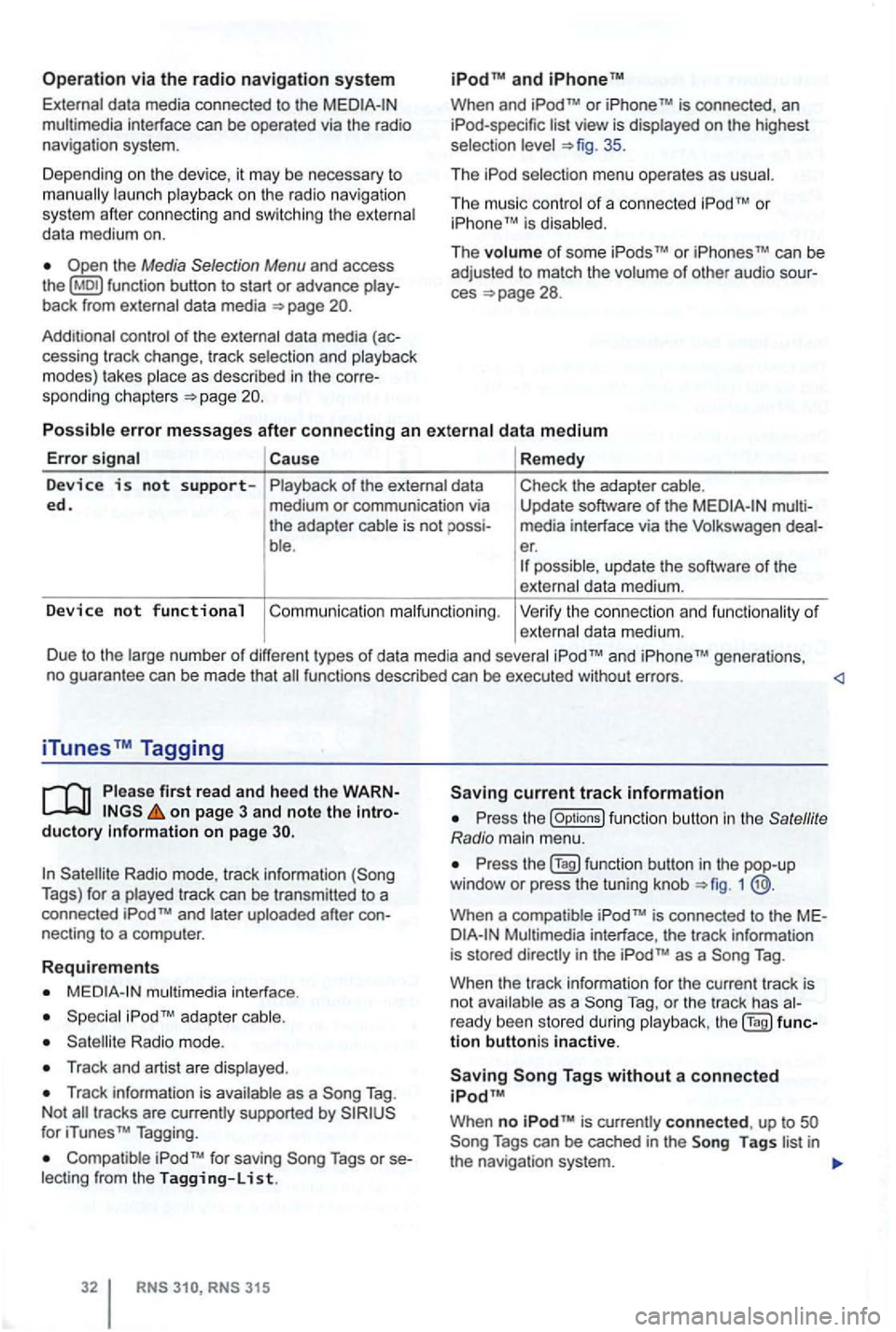
Operation via the radio navigation system
External data media con nec ted to the multimedia interface can be ope rated via the radio
navigation system.
D epend i
ng on th e de vic e, it m ay be necessary to launch playback on t he radio na vigat ion
s ys te m afte r co nn ec ting an d swi tch ing the extern al
d a ta medium on.
back from external data media
con trol of th e externa l data media (ac-
cessing tr ack change, track selectio n and playb ack
m odes) takes plac e as described in the corre-
spon ding ch apt ers
and
When and TM is connected , an list view is displayed on the highest
selec tion 35 .
Th e
The music co ntro l of a conn ected
Cause Remedy
Device is not s upp orted. of the external data
medium or communication via
the adap ter cable is not
ble . Check
the adapter cable.
Update software
of the media interfac e via t he Volkswage n er. possible , update th e software of th e
exte rnal data me diu m .
Device no t functional Co mmu nicatio n malfunctio nin g . Ve rify the con nect io n an d fu n ct ion ality of externa l data m ediu m.
D ue to the large num be r of different types
of d ata media and several gene rations,
no gua ran tee can be made that fu nctions described can be executed without errors.
iTunes Tagging
first read and heed th e on page 3 and note the ductory Information on page
Radio mode, track information Tags) for a played track can be tr ansm itted to a
connected
necting to a compu ter.
Requirements
multimedia interface .
Radio mode.
Track and artist are disp layed .
Track in forma tion is available as a Tag .
N ot
for iTunes TM Tagging.
Compatible Tags or
RNS 315
current track information
th e (Options ) function butt on in the
1
is conne cted to the
as a Tag .
When the track informa tion for the current track is
n ot ava ilab le as a
Tag, or th e tr ack has
tion buttoni s inactive.
When no is currently connect ed , up to
Page 77 of 516
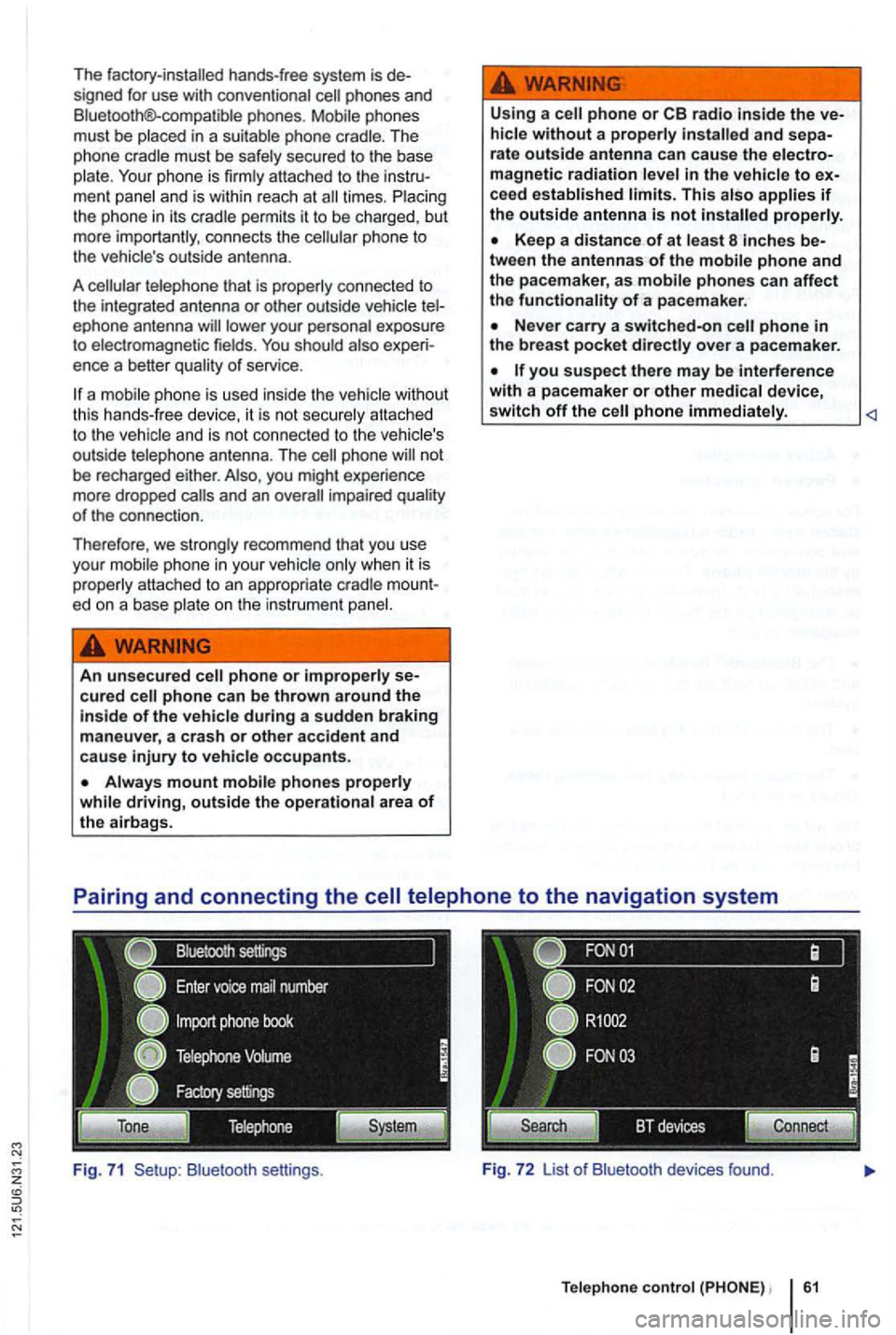
The factory-installed hands-free system is de
s igned for use with conven tional phones and
B luetooth®-co mpatible phones .
ment panel and i s w ithin reac h at times . the ph one in it s cradle pe rmits it to be cha rged, but
more import antly , con nects the phone to
the vehic le's out side antenna .
A
tel ephone that is prope rly co nnected to
the int egra ted ant enna or other outside vehicle ep hone antenna
ence a better qua lit y of serv ice.
a
phone not
be recharged either. you might experience
more dropped
ed on a base plate on the i nstrumen t
An unsecured cured
Always mount mobile phones properly
while driving, outside the operational area of the airbags. U
sing a
phone or radio inside the and sepa-
rate outside antenna can cause the magnetic radiation lev el in the ve hicle to ceed established limits. This a lso applies if the outside antenna is not properly.
Keep a distance of at least 8 inche s be -
tween the antennas of the mobile phone and
the pacemaker, a s mobile phones can affect the functionality of a pace maker.
Nev er carry a switched-on phone in the breast pocket directly over a pacemaker.
B lu etoot h se ttin gs . Fig. 7 2 List o f Bluetoo th devices found.
Te lephone control 61
Page 150 of 516
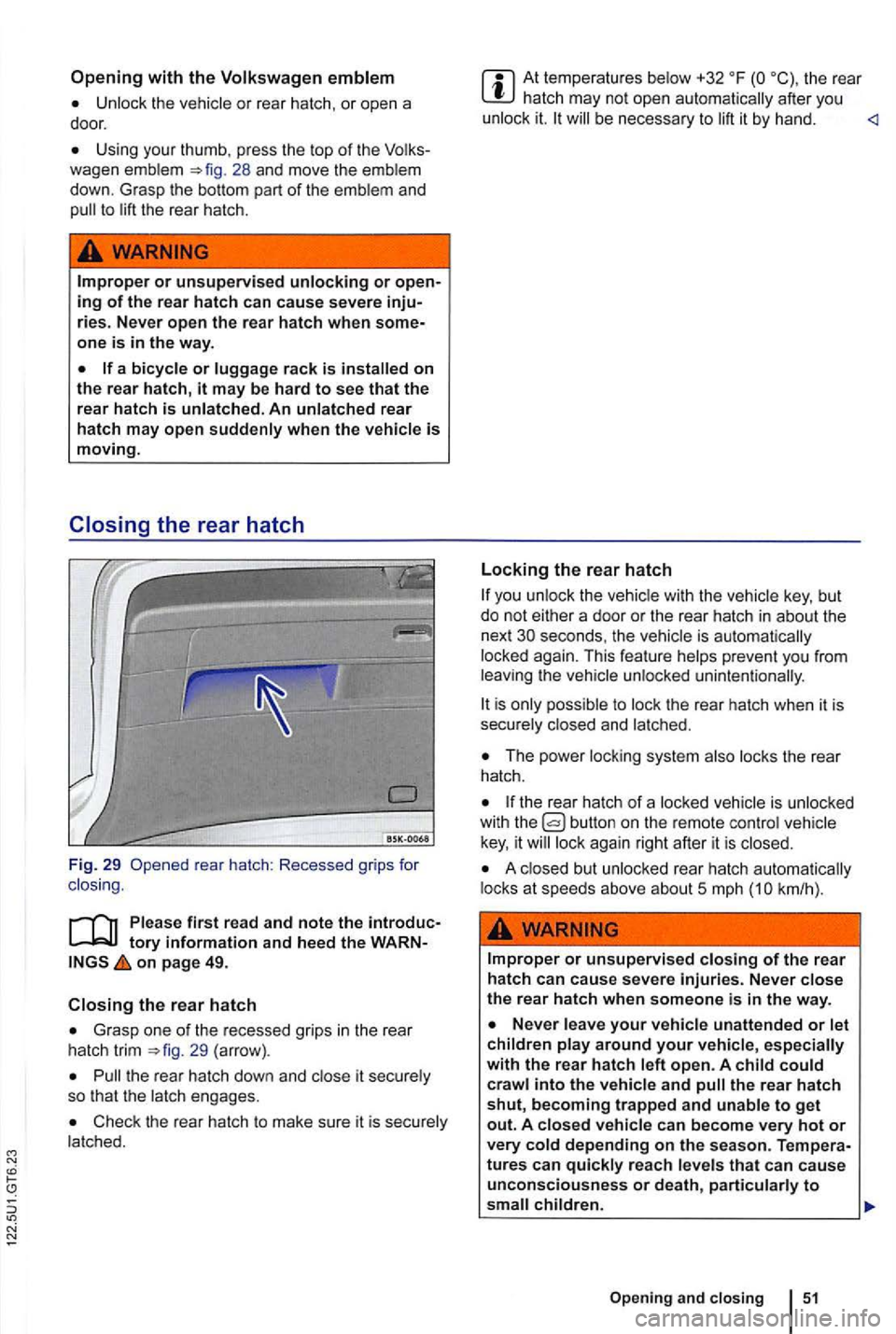
N
with the Volkswagen emblem
Unlock the vehicle or rear hatch , or open a
door.
Using your thumb , press the top of the 28 and move the emblem
down . Grasp the bottom part of the emblem and
pull to lift the rear hatch .
or unsupervised unlocking or ing of the rear hatch can cause severe
a bicycle or luggage rack is installed on the rear hatch, it may be hard to see that the rear hatch is unlatched. An unlatched rear
hatch may open suddenly when the vehicle is moving.
Closing the rear hatch
Fig. 29 rear hatch : Recessed grips for
clos ing .
on page 49.
the rear hatch
Grasp one of the recessed grips in the rear
hatch trim 29 (arrow).
Pull the rear hatch down and close it securely
so that the latch engages.
Check the rear hatch to make sure it is securely
la tched.
At temperatures below +32 the rear hatch may not open automatically after you
unlock it. will be necessary to lift it by hand.
you unlock the vehicle with the vehicle key, but
do not either a door or the rear hatch in about the
next
The power locking system also locks the rear
hatch.
the rear hatch of a locked vehicle is unlocked
with the
lock again right after it is closed.
A closed but unlocked rear hatch automatically
locks at speeds above about 5 mph
or unsupervised closing of the rear
hatch can cause severe injuries. Never close the rear hatch when someone is in the way .
Page 157 of 516
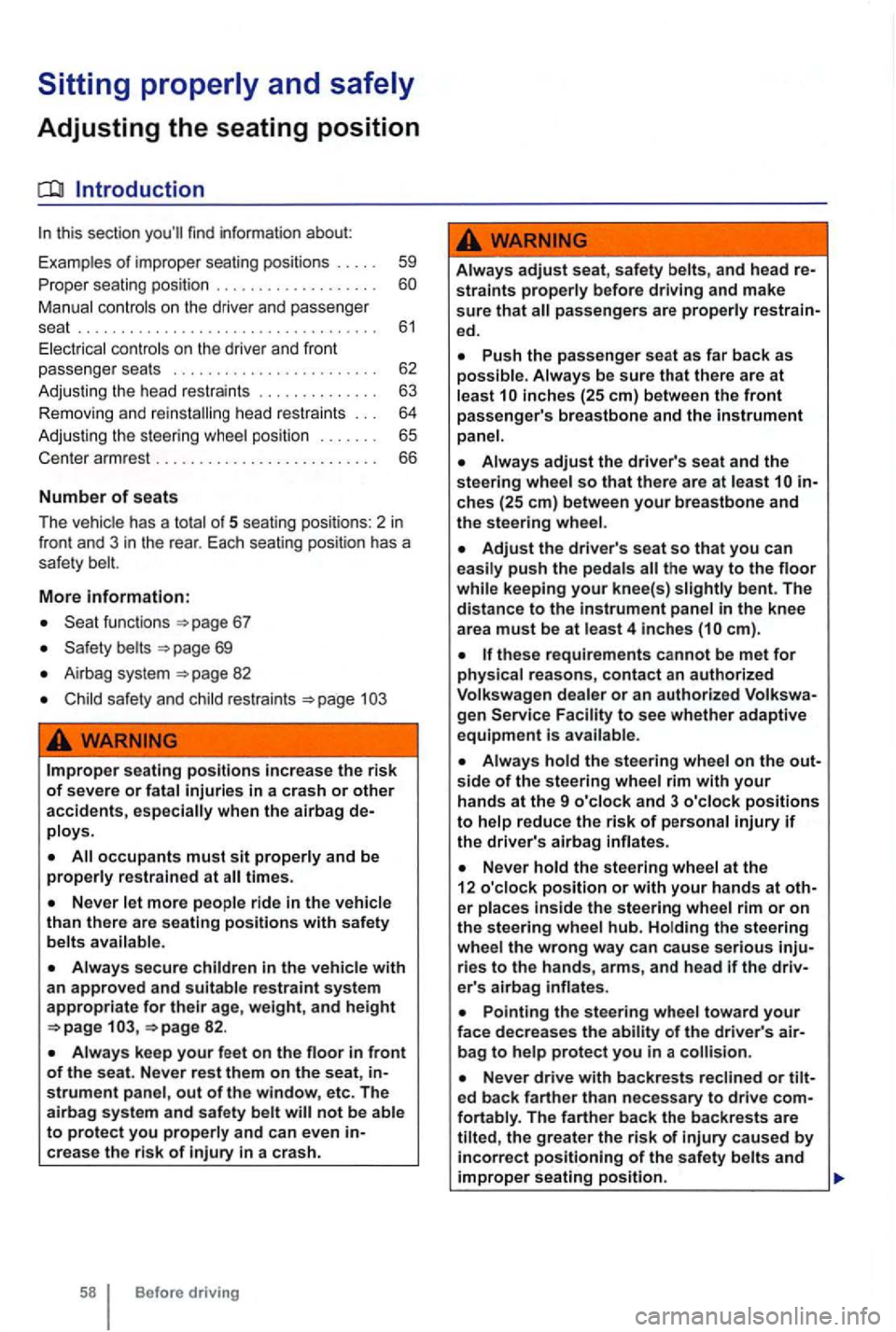
Adjusting the seating position
Introduction
this section find inf ormation about:
Examp les
of improper seat ing pos itions . . . 59
Pr ope r seating position . . . . . . . . . . . . .
Manual contr ols on the driver and passe nger
seat . . . . . . . . . . . . . . . . . . . . . . . . . . . . . . . . . . . 61 Ele ctrica l co ntr ols o n the driver and front
passenger seats . . . . . . . . . . . . . . . . . . . . . . . . 62
Adj ustin g
the head restra ints . . . . . . . . . . . . . 63
R emoving and re in stalling head restraints . . . 64
Adj usting the stee
ring whee l position . . . . . . . 65
Cen te r armrest . . . . . . . . . . . . . . . . . . . . . . . . . . 66
Number of seats
Th e vehicle
has a t otal of 5 seat ing posit ions: 2 in front and 3 in the rea r. Eac h seating pos ition has a
safety belt.
More information:
funct ions 67
page 69
Ai r ba g syste m 82
safety and child restraints
WARNING
Improper seat ing pos itions increase the risk of severe or fatal injuries in a crash or other accidents,
times .
Never
Always secure children in the vehicle with a n approved and suitable restraint system appropriate for their age, weight, and height 82 .
Always keep your feet on the in front of the seat. Never rest them on the seat,
Always adjust seat , safety belts, and head straints properly before driving and make sure that
inches (25 em) betw een the front pa ssenger' s breastbone and the in strument panel.
ches (25 em) between your breastbone and the steering wheel.
Adjust the driver's seat so that you can push the pedals while keeping your knee(s) slightly bent. The
di stance to the instrument panel in the knee
a rea must be at least 4 inche s
these requirements cannot be met for physical reason s, contact an authorized
Volk swagen dealer or an auth orized gen Facility to see whether adaptive equipment is avai la bl e.
Always hold the steering wheel on the side of the steering wheel rim with your hands at the 9 o'clock and 3 o'clock positions to help reduce the risk of personal injury if the driver's airbag inflates .
Never hold the steering whee l a t the
12 o'clock position or with your hands at e r places inside the steering whee l rim or on the steering wheel hub. Holding the steering wheel the wrong way can cause serious rie s to the hand s, arm s, and head if the
Pointing the steer ing whe el t oward your face dec reases the of the driver's bag to h elp protect you in a
Never drive with backrest s reclined or ed back farthe r than necessary to drive
Page 162 of 516
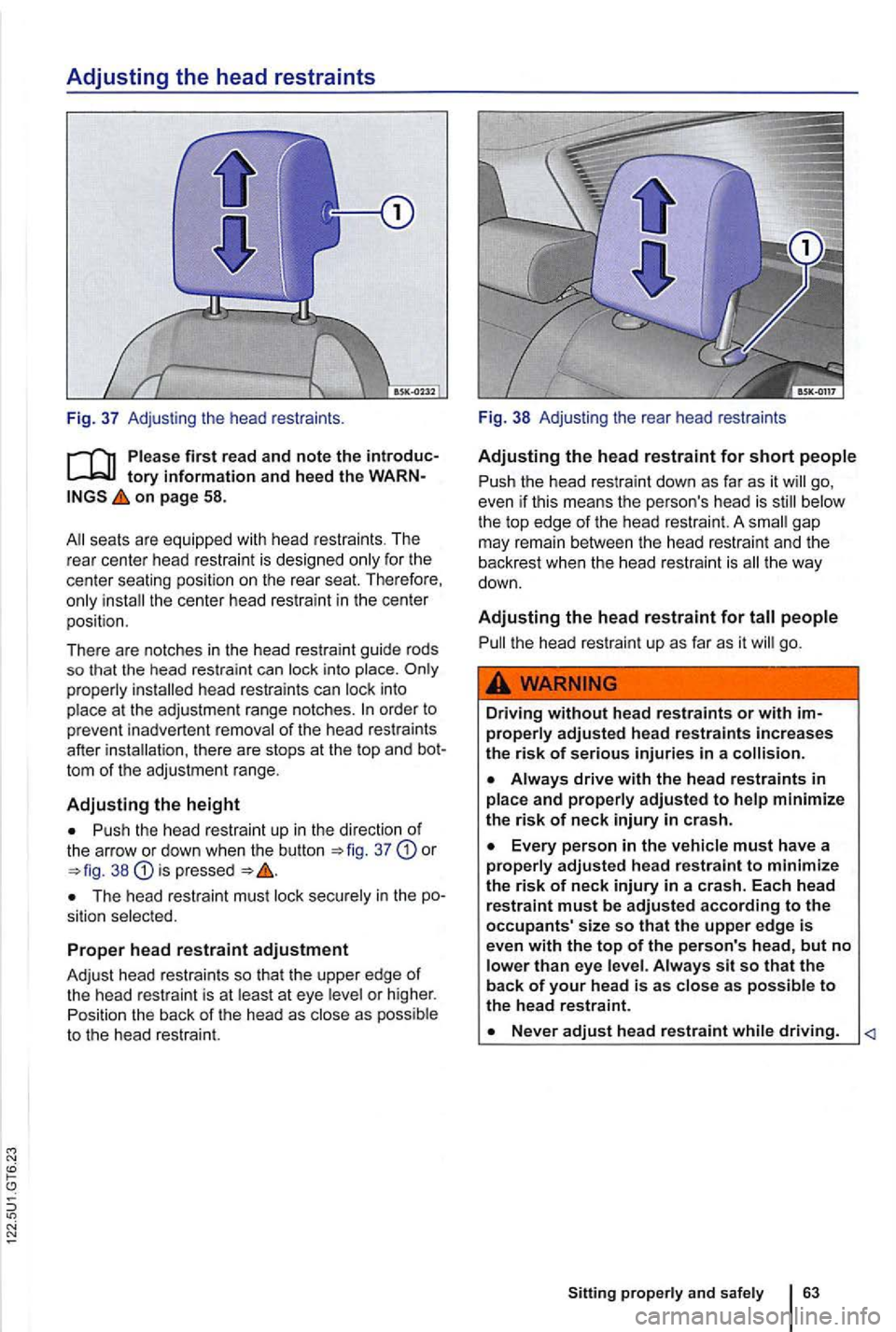
Adjusting the head restraints
Fig. 37 Adjusting the head restraints .
on page 58.
th e ce nter head rest rai nt in th e center
pos ition.
There are notches in the head restraint gu ide rods
so that the head restraint can lock into place .
prope rly
tom of the adjus tment range.
Adjusting the height
37 o r 38 is
The head restraint must lock secu re ly in the
gap
may rema in betwee n th e head restra int and th e
ba ckrest when the head rest r
aint is t h e way
down .
Adjusting the head restraint for
go.
Dri v
ing without head restraints or with properly adjusted head restraints increases
the risk of serious injuri es in a collision.
Page 168 of 516
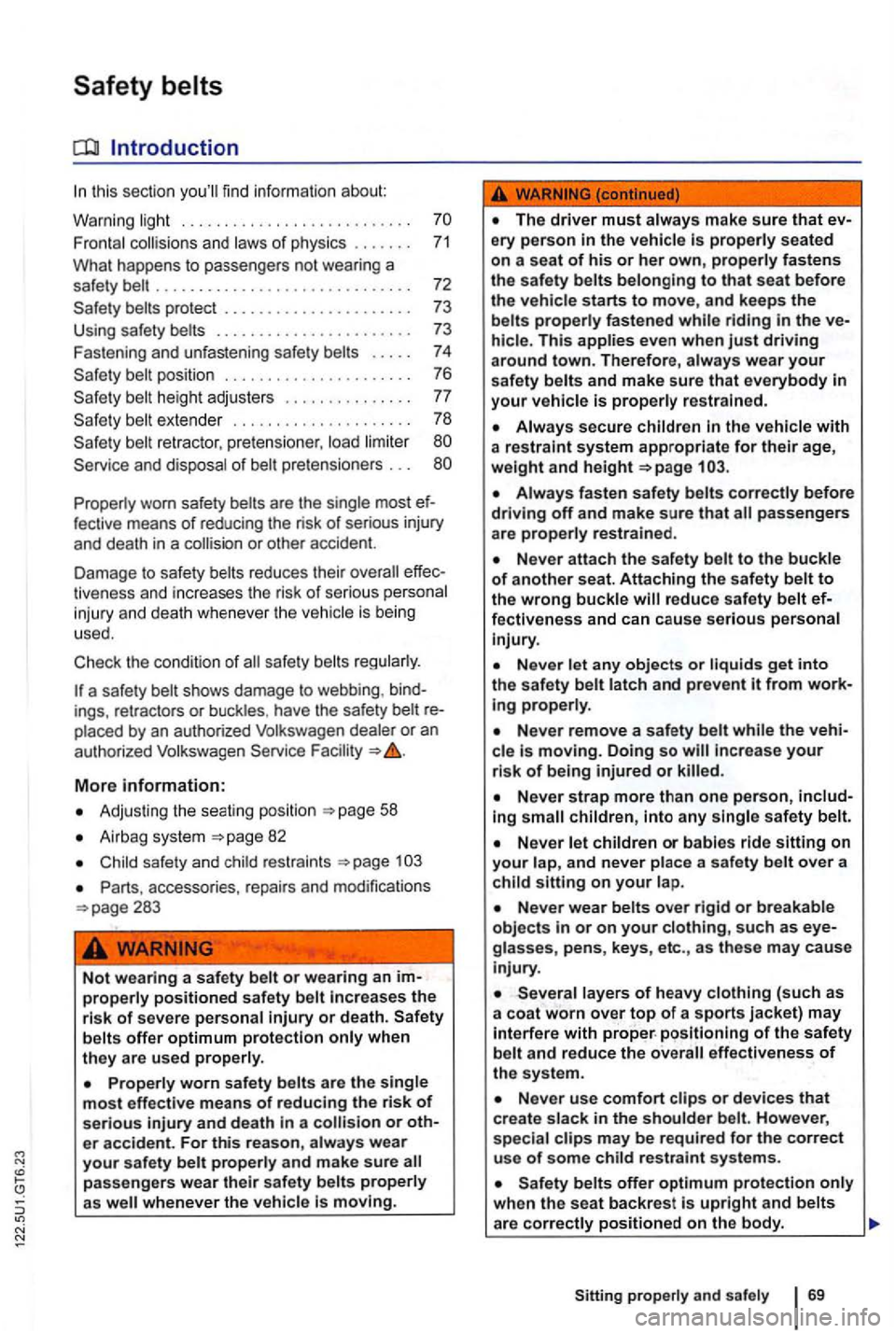
find informati on about:
Fro nt al
Properly worn safety fective means of reducing the risk of serious injury
and death in a or othe r accident.
D amage to sa fety belts reduces their
tiveness and increases the risk of se rious personal
i nj ury and death whenever the vehicle is being
used .
Check the conditi on of
a safe ty belt shows damage to webbing , ings, retracto rs or buckles . have the safety belt
More information:
Adjusting the seating posit io n
Airbag system
Child safety and child restraints 103
Parts , access ories, repai rs and modifications
Properly worn safety belts are the single most effective means of r educing the risk of serious injury and death in a collision or er accident. For this reason , always wear your safety belt properly and make sure all
pa ssengers wear their safety belts properly as well whenever the vehicle
The driver must always make sure that
hicle. Thi s applies even when just driving around town. Therefore, always wear your safety belts and make sure that everybody in your vehicle is properly restrained.
Always secure children
Always fasten safety belts correctly before driving off and make sure that all passengers
are properly re strained .
Never attach the safety belt to the buckle of another seat. Attaching the safety belt to the wrong buckle will reduce safety belt fectiveness and can cause serious personal injury.
cle is moving. Doing so will
small children, into any single safety belt.
Never wear belts over rigid or breakable objects in or on your clothing, such as glasses, pens, keys, etc., as these may cause injury.
layers of heavy clothing (such as
a coat worn over top of a sports jacket) may with proper. positioning of the safety belt and reduce the overall effectiveness of the system .
Never use comfort clips or devices that create slack in the shoulder belt. However,
s pecial clips may be required for the correc t
u se of some child res traint systems.
Page 172 of 516
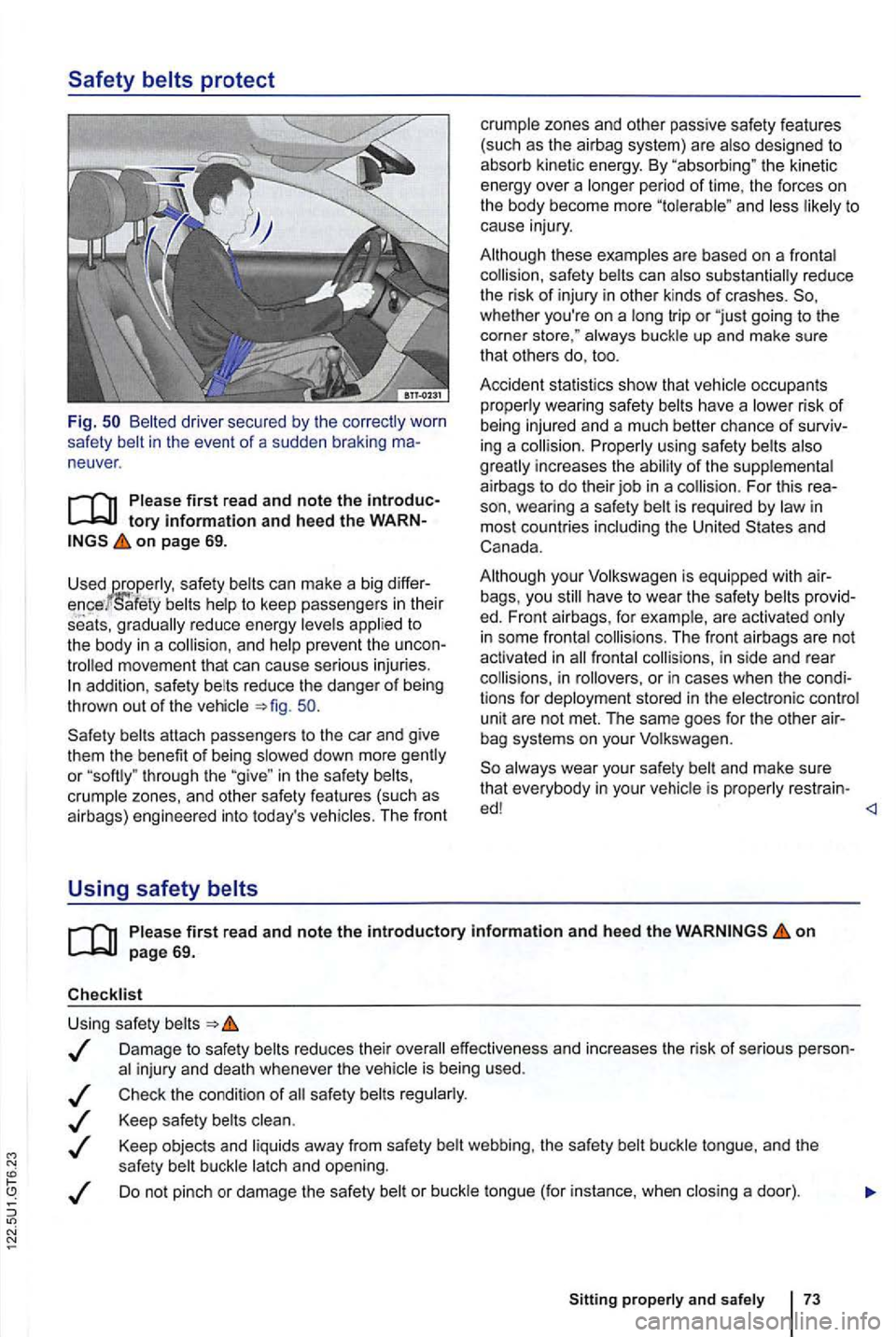
Safety belts protect
Fig. Belted driver secured by the
neuver .
on page 69.
Used safe ty can make a big
to
the body in a co llision , and help prevent the
addition , safe ty reduce the danger of being
thrown out of the vehicle
or through the in the safety crumple zones, and other safety features (such as
airbags) engineered into today's The front
Using safety belts
crumple zones and other passive safety features
(such as the airbag system) are also designed to
absorb kinetic energy. By "absorbing " the kinetic
energy over a longe r pe riod
of time, the forces on
the body become more to
cause injury.
Although these examples are based on a fronta l
collision , safety
whether you're on a long trip or "just going to the
corner always buckle up and make sure
that others do, too.
Accident statist ics show that vehicle occupants
p roperly wearing safety
also
g reatly increases the ability of the supp lementa l
airbags to do thei r job in a collision. For this is required by in
most countries including the United
your Volkswagen is equipped with have to wear the safety
bag systems on your Volkswagen.
always wear your safety is properly restra in -
ed!
o n
Damage to safety reduces their overall effectiveness and increases the risk of serious injury and death whenever the
Check the condition of
webbing , the safety buckle tongue, and the
safety buckle latch and opening.
Do not pinch or damage the safety
Page 202 of 516
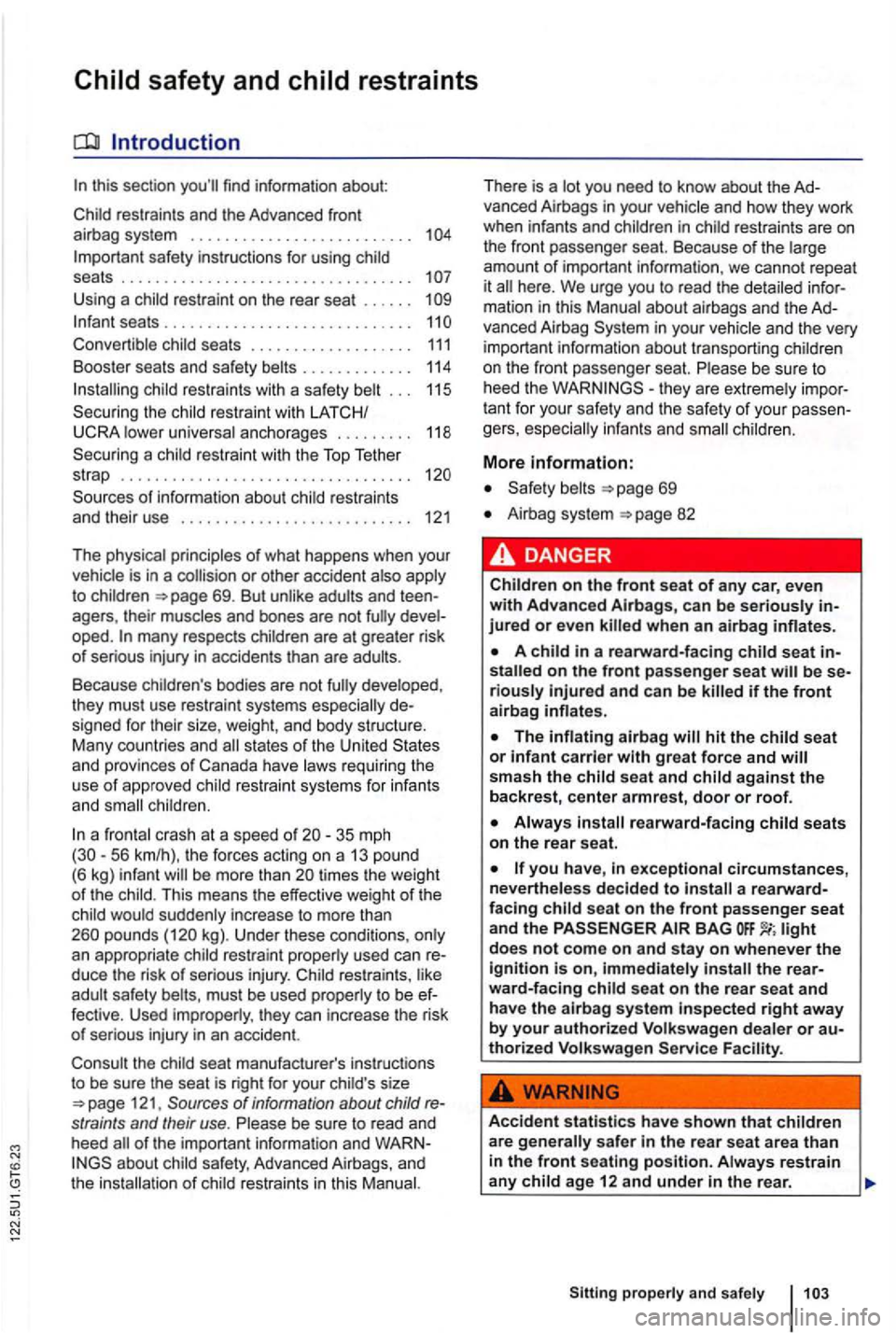
Child safety and child restraints
this section
Important safety inst ructions for using child
seats . . . . . . . . . . . . . . . . . . . . . . . . . . . . . . . . . .
U sing a child restraint on the rear seat . . . . . .
Infant seats.............................
res traints with a safety belt . . . 115
Securing the child restra int with LATCH/
U CRA lower universa l a n cho rages . . . . . . . . . 118
Secu ring a chil d rest rai nt wit h the
Top Tether
st rap . . . . . . . . . . . . . . . . . . . . . . . . . . . . . . . . . .
or other acciden t also apply to children
de
signed for th eir size. weight, and body structu re .
M any countries and
states of th e United States
and provinces of Canada have laws requ ir in g t he
use of approved child res traint sys tems fo r i nfants
and
a fron ta l crash at a speed of
be more than times the weight of the child. This means the effective weight of the
kg) . Under these conditions . only
an appropriate child restraint properly used can re
duce the risk
of serious injury. Child restraints, like safety must be used properly to be ef
fe ctive. Used improperly, they can increase the risk of serious injury in an accident.
the child seat manufacturer's instructions to be sure the seat is right for your child's size 121, Sources ofinformation about child re
straints and their use. Please be sure to read and
heed
abou t child safety, Advanced Airbags, and
the
Safety
Airbag system
A child in a r earward -fac ing child seat in
stalled on the front pa ssenger seat
se at and
Always re arward-fa cing child seats on the rear s eat.
you ha ve, in exce ptional circumstances,
nevertheless d eci de d t o sea t on the front passenger seat
a nd the PASSENGER light does not come on and sta y on when ever the ignition is on , immed iatel y th e rear
w ard-fa cin g sea t on the rear se at and have the airba g sy s te m insp ec te d right aw ay
by your authorized Volk sw age n dealer or authorized V olk sw age n Service
Accident statistics h ave sh own that c h ildren
are sa fe r in the rea r se at are a than
i n the front seating position . A lw ay s restrain
any a g e 12 and unde r in the rear.
Sittin g properl y and safe ly